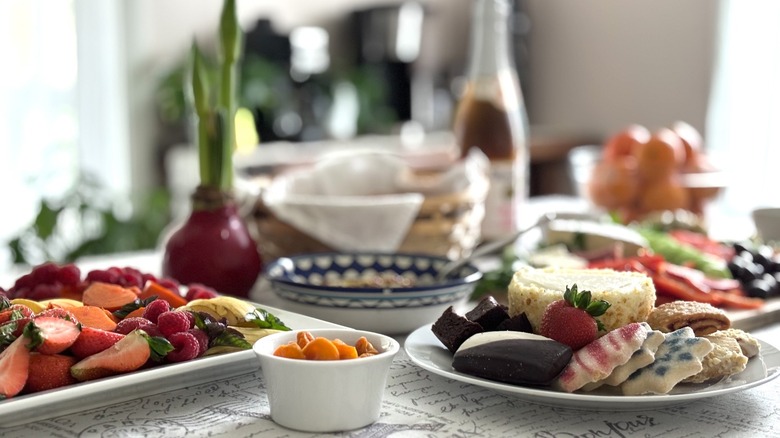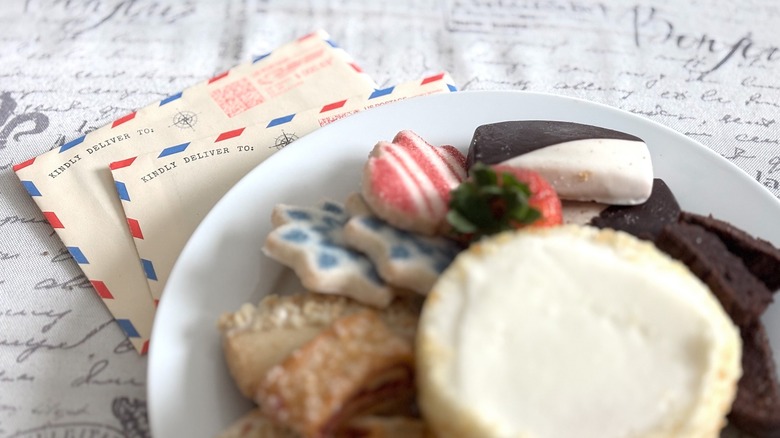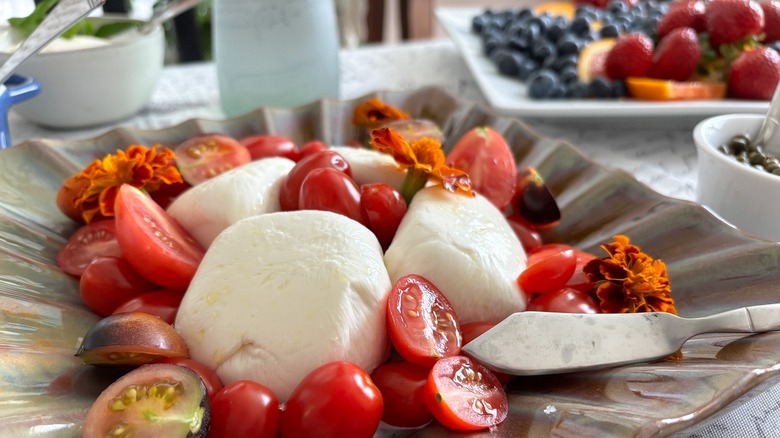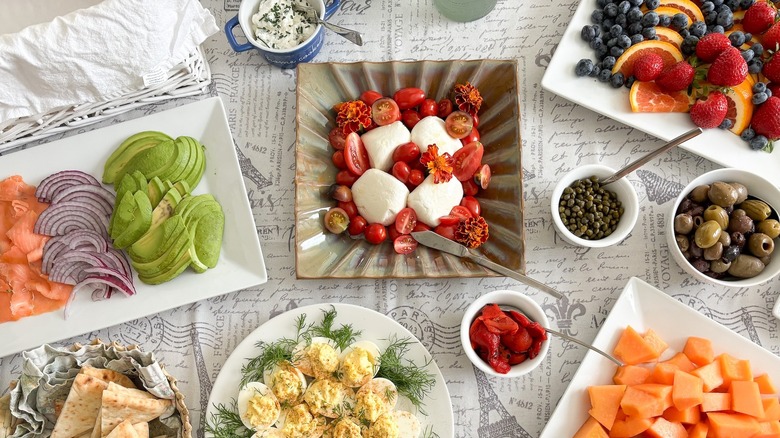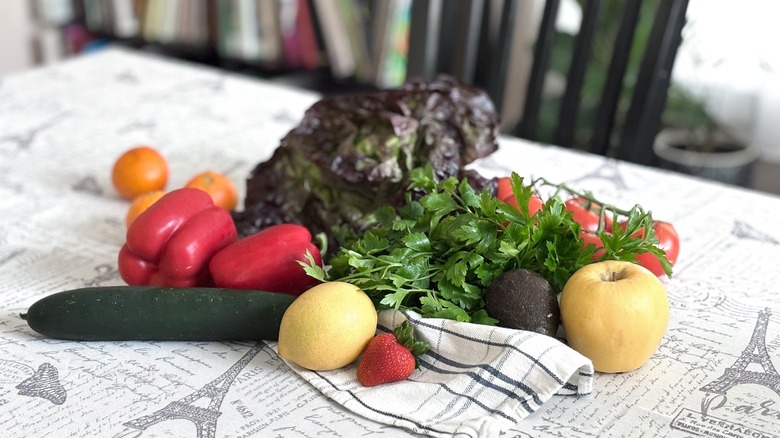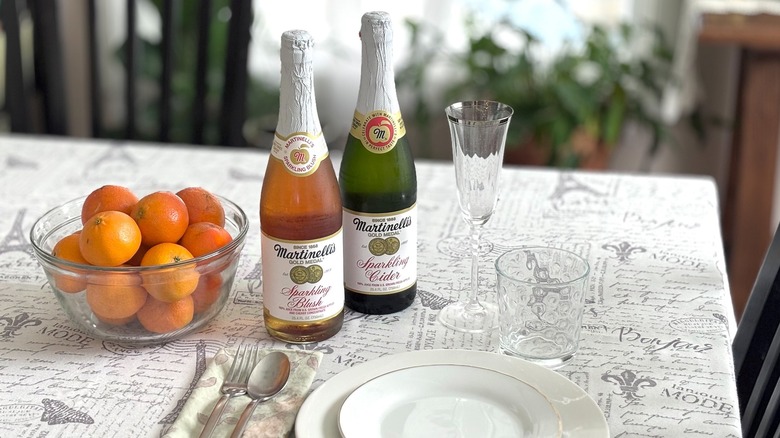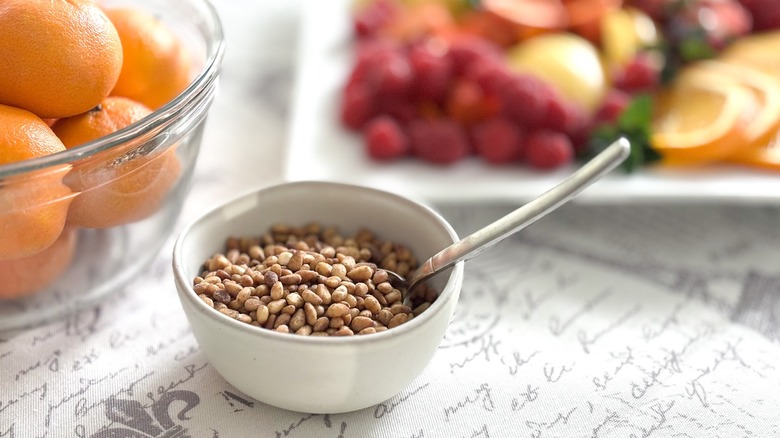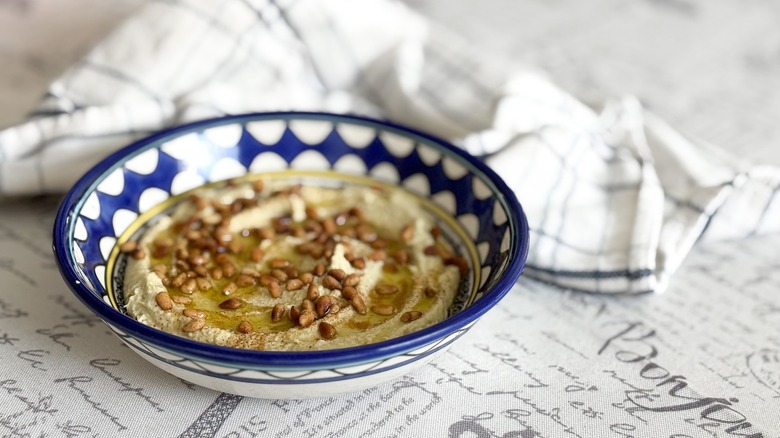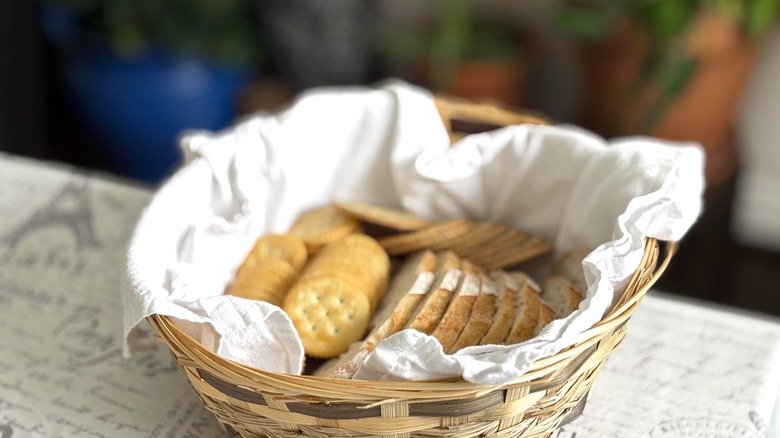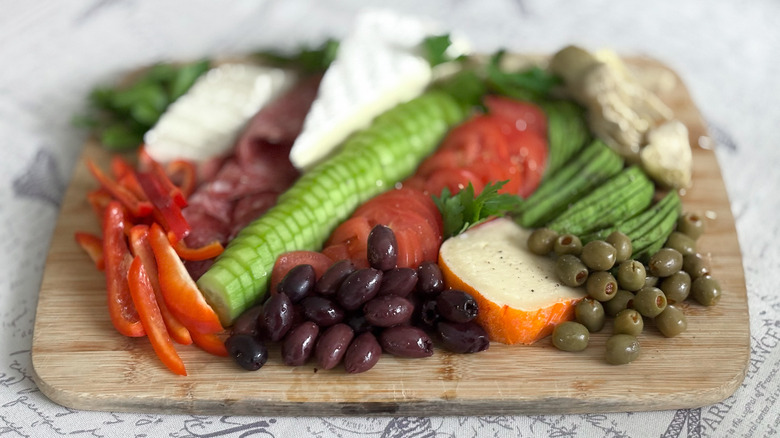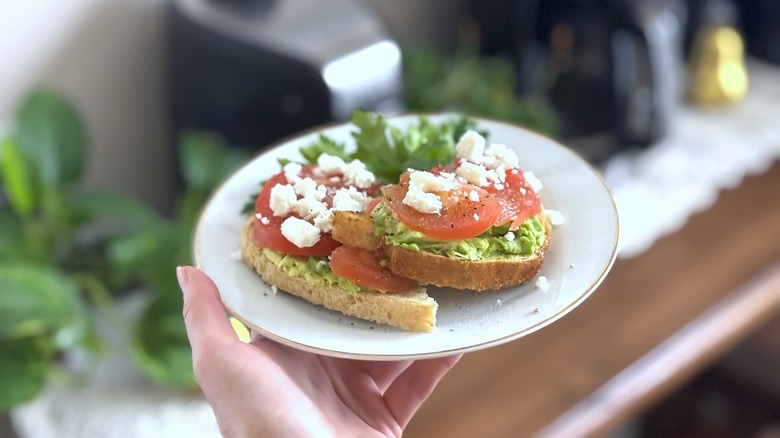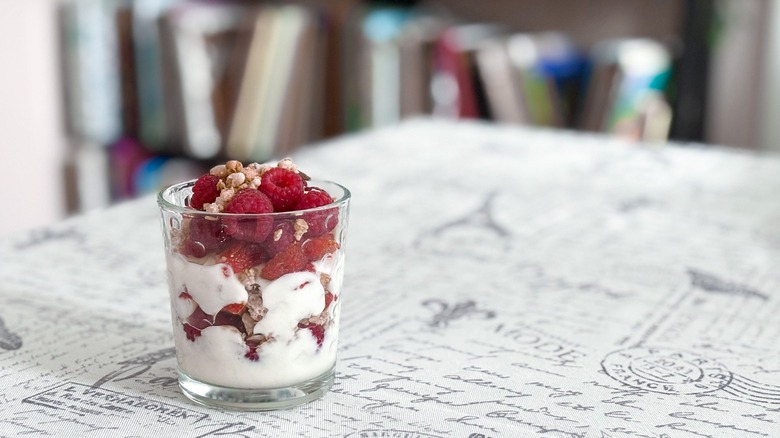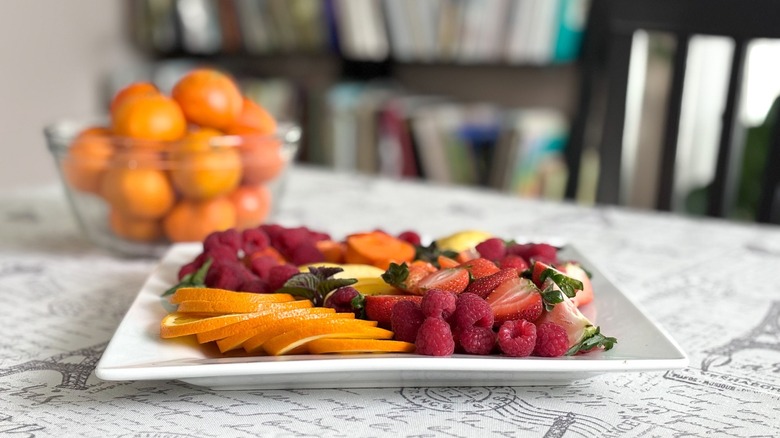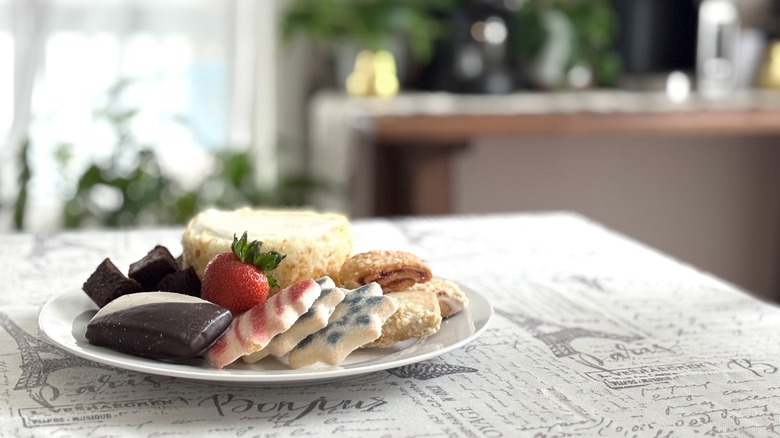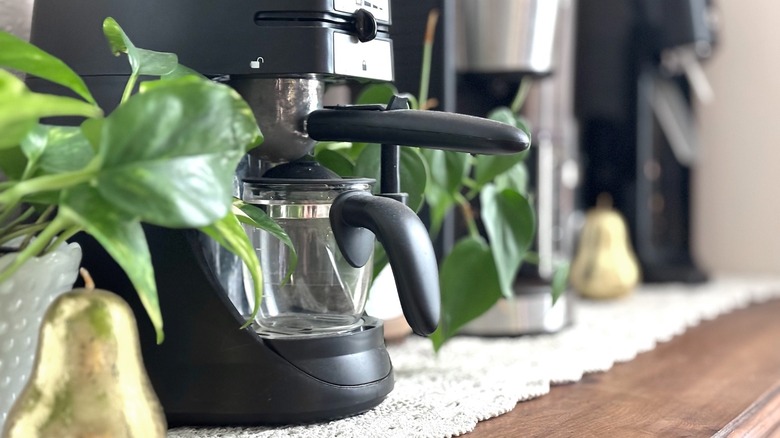How To Throw An Easy No-Cook Brunch
We may receive a commission on purchases made from links.
Brunch is fun, and with restaurant prices being what they are these days, it's never a bad idea to host one yourself. However, "brunch" has become such a culturally laden term that many people are intimidated by the idea of throwing one. Are you even brunching if you don't offer eight kinds of cheese, eggs, meat, seafood, and fruit? Not to mention a flight of bellinis, a DIY shakshuka station, eggs Benedict for all, or a pancake bar? Yes, creativity is fun, but it's not always required.
The truth is, if you ditch the cooking element, brunch becomes a lot easier. Yes, you can throw a brunch without turning on the oven, lighting the stove, or opening the microwave door. Plus, once all the appliances are out of the picture, the house doesn't get all hot and steamy ... sometimes a real concern in the summer. All that's required to do brunch better is to make it a no-cook affair, and there are plenty of easy ways to do that.
Plan a week to a month in advance
How far in advance do you have to plan your brunch? Some people say that spontaneity is fine, and if you have people in your circle who will go for it and it doesn't stress you out, have at it. However, others (and perhaps you) will need more lead time.
The experts take different approaches. Breen Halley, an event planner at Halley Events, says, "I suggest planning a brunch at least 30 days in advance. Most of your guest list might plan full weekends, so giving them plenty of advance notice is best for you and them."
Meal planning expert and Mealfan SEO, Eric Sornoso, on the other hand, is fine with less time, especially for something like an informal brunch. "A week's notice generally works well," he says. "You will have time to issue invitations, plan your menu, and do your shopping." Most folks fall somewhere in between, such as Julia Chebotar of Health Chef Julia, Food Network's "Chopped" Champion. "I think it's best to start at least one week in advance," she says. "This gives you time to plan the menu, shop for ingredients, and organize any serving ware you'll need."
Keep it intimate
The whole goal when throwing brunch at home is to make it easy on yourself. Otherwise, you might throw up your hands and just order fast food instead. One of the best ways to keep it simple is to keep it small, because that way, you're not planning for nearly as much in the way of seating, dishware, glassware, shopping, and food prep. Plus, you don't have to integrate clashing personalities or people who don't know one another. Remember, brunch can be simple and fun; it doesn't have to involve 20 feuding family members.
What constitutes "intimate," then? "For an intimate brunch, I suggest 4 to 8 people," Julia Chebotar says." This size allows everyone to engage in meaningful conversation while keeping the vibe relaxed and manageable for the host." This amount works well for no-cook brunches, leaving plenty of time for eating and conversing without feeling pressed for time or overcrowded, Eric Sornoso adds.
Breen Halley says, "Keeping the headcount at ten and under allows you to host an intimate brunch without additional seating and potentially needing to source rentals." If you don't have an expansive setup, that's a major plus.
Curate a theme and plan a menu
Breen Halley points out that planning a month in advance also gives you plenty of time to mull your theme and menu over. "Developing a menu that requires no cooking for more straightforward hosting includes ideas such as a charcuterie board or cones, tartines, orzo salad, prosciutto, and melon skewers," she says. Her personal favorite is "a chilled chicken and avocado salad with halloumi (using a store-bought rotisserie chicken is a great time saver)."
If that sounds like a good menu to you, go ahead and grab it for your own. Otherwise, you can research on Pinterest or food blogs to figure out what no-cook brunch options look best to you. Choosing a brunch theme can help direct your thinking. Fun prospects include travel, Southern Comfort, Red Carpet, or Bridgerton.
Shop for produce no more than 2 days in advance
Although it might feel tempting to lay in supplies further out and reduce the work you'll have to do in the days leading up to your brunch, this isn't the best idea. Fresh fruit and veggies are best in their first one or two days, says Julia Chebotar. "Fresh produce is key for no-cook brunches," she adds, so plan your shopping trip accordingly.
If you don't have time to shop in that window due to work or another duty, consider online shopping. Experts estimate that online grocery delivery is about 10% more expensive than heading to the store yourself. There's also the fact that you're likelier to choose nice produce than someone who shops for others. However, if you need the time, the option is there.
Decorate and tablescape the day before
Ideally, you can set aside some time the day before to complete pre-brunch tasks, such as reviewing your menu, prepping foods that aren't time-sensitive, and decorating and tablescaping. "To make the experience stress-free, set up serving space ahead of time," Eric Sornoso adds. This enables you to visualize the layout of your table, so you're not fretting about where to put what when you're half-dressed and scrambling around.
Here's a hack: Post-It notes. Whenever I have brunch for people earlier in the morning and I don't want to feel scattered, I lay out the tablecloth and serving platters the night before, then use Post-Its to indicate which food goes where. Pull out napkins, silverware (which looks nice stuffed into a mason jar), serving dishes, and coffee carafes.
You might consider a presentation platter or two when putting out your dishware. If you're younger or otherwise just getting into hosting, this is a worthwhile investment. Platters are a major step up on regular dinner plates as serving vessels, and a three-tier serving stand makes an elegant statement piece. Lastly, Julia Chebotar says, always do your flowers the day before.
Prep dry goods in advance as well
Dried goods are the most forgiving when it comes to no-cook brunches because they're already shelf-stable. In the days leading up to your brunch, you can roast or candy nuts, make nut mixes, or bake anything you might want to bake (hey, no one said it's illegal to do a little pre-cooking for your brunch). When done, put them into airtight containers until ready to serve.
It's important to note that you shouldn't combine ingredients willy-nilly, though. For instance, mixing some dried fruit and nuts together ahead of time will make the nuts soggy. This is especially true if you're using a really moist fruit, such as apricots. Similarly, if you slice bread and put it in a basket with crackers, then cover it, the higher moisture from the bread will soften your crackers. So be aware and, where possible, keep ingredients separate till the end.
Prepare marinated foods, sauces, and platters the day before
Many dishes you serve in a no-cook brunch are cold, so they'll survive nicely in the refrigerator overnight. Sauces like tzatziki, tahini, hummus, or dip can all be prepared a day in advance. Indeed, they're often better once the flavors meld a little bit, which is also true of fruit salad or compote, Julia Chebotar says. She also advises preparing pre-slice vegetables, cheeses, and charcuterie for easy assembly the next day. Olives, capers, and pickles are also very amenable to preparation ahead of time.
Anything you prepare before must be protected so it doesn't degrade or lose flavor, though. If you assemble a charcuterie board the day before, Sornoso says, wrap it tightly. The same goes for a mezze platter, sauces, and dips. If you feel like it, adds Breen Halley, "You can also prepare mini fruit and yogurt parfaits ahead of time."
More delicate foods can also be prepared further in advance, as long as you're careful. For instance, you can make deviled eggs up to two days before, but don't put the filling into the eggs until you're ready to serve them. You can buy hard-boiled eggs from the grocery store if you're truly determined to do no cooking.
Cut up whatever you can the day before
Julia Chebotar advises a rich and varied rainbow of produce, such as crudités with guacamole or tahini sauce, endive leaves with dip, or fresh fruit and savory food combos, "like pairing peaches with burrata or figs with prosciutto." Where possible, never buy pre-made veg, Breen Halley adds: "Skip the store-bought veggie platters and prepare your own crudité platter by visiting your local market and picking out the freshest in-season vegetables to pair with creamy dips."
Eric Sornoso agrees, offering fruit skewers and veggie roll-ups as additional produce-forward choices. For the former, cube fruit and string it onto wooden or metal skewers, then arrange them in a dish as you would grilled kebabs or vegetables. To make the latter, smear cream cheese or hummus on tortillas or lavash, then layer with thinly sliced veggies and roll them into pinwheels before slicing.
Washing, drying, peeling, cutting, and chopping produce is one of the most labor-intensive aspects of cooking for any meal, and brunch is no exception. The emphasis on no-cook finger foods such as sliced veggies and fruit platters does make for a nice exception to other types of meal prep, though, as you don't have to finely dice or shred anything (with the possible exception of some salad veggies). To save even more time, try to cut up whatever fruits and veggies you can the day before.
Create or outsource centerpieces and showstoppers
It's always nice to have one centerpiece, a large dish or platter in the middle of your table and anchors the rest of your beautiful spread. When you're cooking, the range of possible showstoppers is vast, but with a no-cook brunch, you're usually looking at charcuterie.
Julia Chebotar suggests you make "A gorgeous cheese and charcuterie board featuring soft cheeses like brie, fresh burrata, and accompaniments like fig jam and olives." Nuts and crackers are a nice addition, says Eric Sornoso. If putting together a board like that isn't something you have time for or isn't your strong suit, no worries. "It's ok to outsource this as many local businesses now specialize in curating delightful offerings," Breen Halley says.
Cheese knives make for an elegant addition to your charcuterie board or cheese plate and they're not very expensive. Naturally, no one will judge you if you put out a sharp paring knife for hard cheeses and a butter knife for soft ones. If you want to go hog wild on brunch gear, buy a set that includes both a charcuterie board and cheese knives, as well as a drawer in which to store the latter. It both saves space and prevents headaches.
Make a bagel or avocado toast bar
Avocado toast is more than a food; it's a cultural icon. It's the subject of memes, rampant across food blogs with innumerable twists, and just frankly really yummy. Unlike the avocado toast that costs around $14.95 at a restaurant, you can make it affordably at home as a lovely brunch centerpiece.
To make an avocado toast bar, Eric Sornoso says, "Display sliced bread, mashed avocado, and toppings such as cherry tomatoes, radishes, lemon wedges, and chili flakes for allowing creativity." Julia Chebotar would add "various toppings like microgreens, radishes, pickled onions, and everything bagel seasoning" to that list. Speaking of bagels, you can also sub out your avo for a smoked salmon platter instead. "Great to eat and a real crowd-pleaser, this dish serves bagels, cream cheese, capers, finely sliced onions, and fresh dill," Sornoso explains.
Salad makes a nice addition to bagel and toast spreads. It's fresh and green, perfect for complimenting the rich dairy and heavy baked goods. It's a good idea to have dedicated salad tongs on hand. While you can certainly serve salad with two large forks or wooden spoons, the effect is nicer. Plus, that way they won't be coopted for use in other dishes, which can muddy the brunch waters.
Set up a parfait or smoothie station
Nothing is cuter than a "station" of any kind at brunch. All three experts Chowhound talked to recommended creating either a smoothie or parfait bar, giving people the flexibility to bend your dishes to their taste (and removing any allergen concerns for you, such as with tropical fruit or nut milk).
For a smoothie station, Eric Sornoso says, put out pre-portioned frozen fruits and greens along with various types of milk and yogurt. You can go two routes with the blender. If you want to keep noise out of the main space, leave your smoothie station in the kitchen. If you want your smoothies to be a real activity, bring them into the serving area and make them the star of the show, with lots of fresh fruit, veggies, frozen items, and liquids. This is the blender and ice crusher we have, and it works pretty well. It's not the nicest one on the market, but if you need to upgrade and don't have a lot of funds to do it, it's a good way to go.
If you're going to do a parfait station, go ahead and use that as your statement piece. Parfaits are so charming, so get some glassware that highlights their brunchy perfection. You can find affordable parfait sets with both glasses and spoons online, which are adorable both at brunch and sitting in your cabinet. Then put out ingredients such as "organic Greek yogurt, homemade granola, and an array of berries, nuts, and seeds," Julia Chebotar says. Sornoso also loves mango, while Breen Halley thinks acai is a nice addition as well.
Don't forget a giant fruit platter
Fresh fruit is a brunch must. There's a reason fruit is almost always an option for a brunch side and listed on every menu as an extra available for purchase. Folks love fruit at every meal, but especially for breakfast and brunch, when it provides a fresh and nourishing counterpart to all the heavier foods.
You can take two basic approaches to fruit. A tossed salad with the usual suspects of apples, melons, oranges, and berries is always nice. If you're going that route, add delicate berries at the last minute so they don't get spoiled and mushy. You should also drizzle lemon or lime over apples, pears, and oranges to avoid discoloring. The citric acid will keep them fresh and bright until you're ready to serve.
The other approach is a platter. Julia Chebotar is in favor of this one, and loves to turn up the volume, as Ina Garten likes to say, opting for "A seasonal fruit platter with a drizzle of honey, fresh mint, and a sprinkle of chili flakes for a little kick."
Sweets matter!
Who doesn't love sweets for brunch? No one, that's who doesn't. Even if you're not offering a heavy-hitting pastry assortment or doing a pancake or waffle bar (which could technically count as no-cook because the actual cooking is DIY for each guest), you still want to make a nod to the sweet tooths out there.
Cinnamon rolls are a regular favorite, often suggested as a brunch sweet along with muffins and scones. If you want, you can prepare these ahead of time so that you don't have to cook on the day, or you can go fully no-cook and buy them. If your brunch is a little later, you might consider a cheery cake option, such as carrot cake or cupcakes.
If possible, give people different plates for dessert. It's both adorable and classy to bring out a nice stack of dessert plates with clean cocktail napkins and forks. Make sure to put out cake servers or slicers the day before when you're preparing your tablescape.
Put out hot and cold drink options
Not all foods and drinks work well together, so you should keep that in mind when putting out your beverages. For instance, eggs and alcohol are notoriously hard to pair, mostly because eggs are delicate in flavor and booze can overpower them. If you're serving eggs with cocktails, keep them light, with juices and seltzers to mix. If you don't want to bother with mixers, choose bubbly or light white wines for brunch.
Of course, most brunches expect coffee as an option. If you want, you can break the no-cooking rule to become your own barista, as home espresso machines are reasonably affordable and easy to use. Drip coffee is the easiest route, though. Just make sure you have a well-insulated coffee carafe on hand to keep beverages flowing. Two is better; that way you can serve the decaf crowd too.
Other drinks you might want to consider include tea (an electric kettle is handy here), juices, and soda water. If you have one, put your Soda Stream and flavorings somewhere that guests can access them easily. During the holidays, you might consider putting out a treat such as eggnog or mulled cider too.
